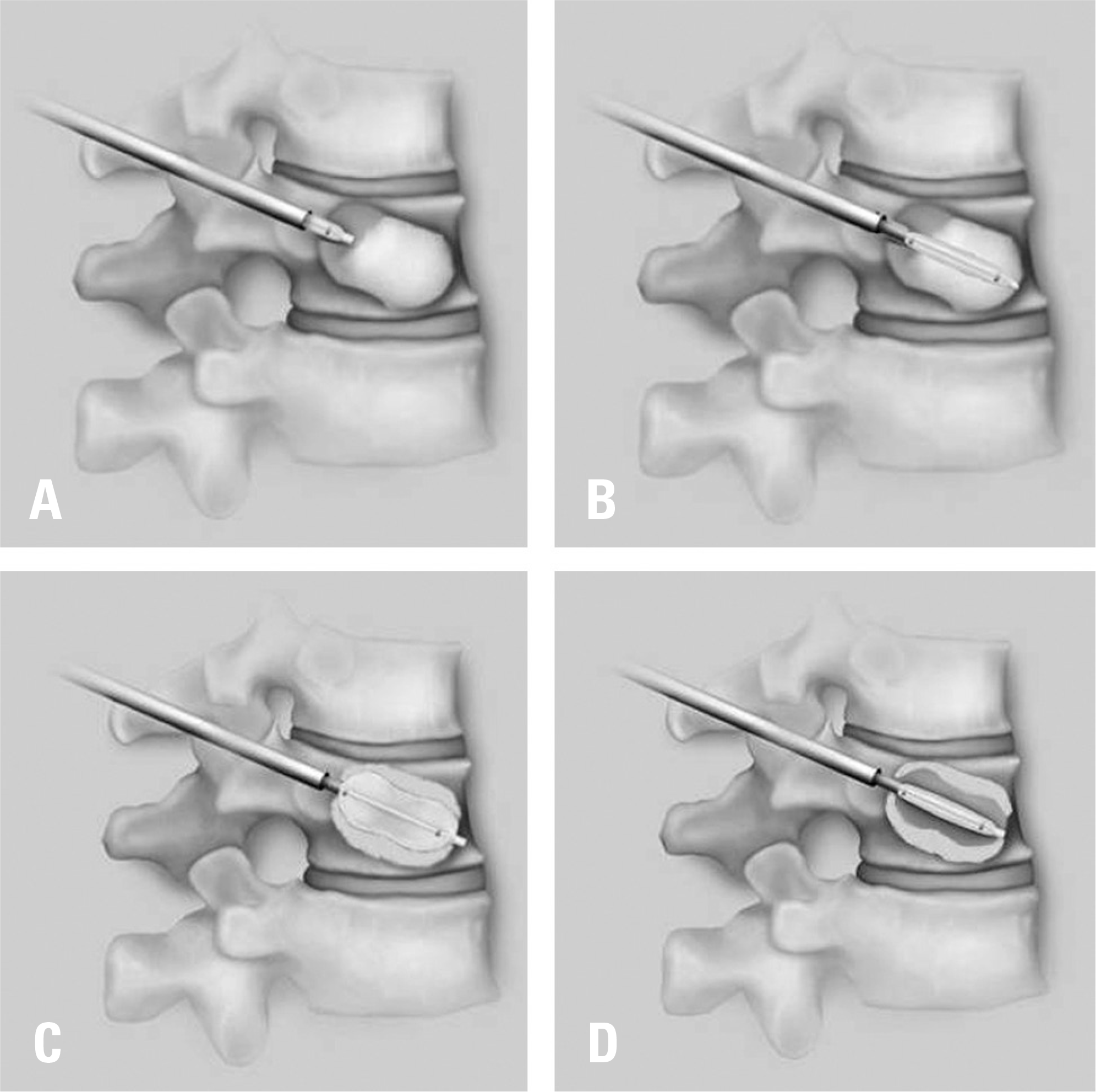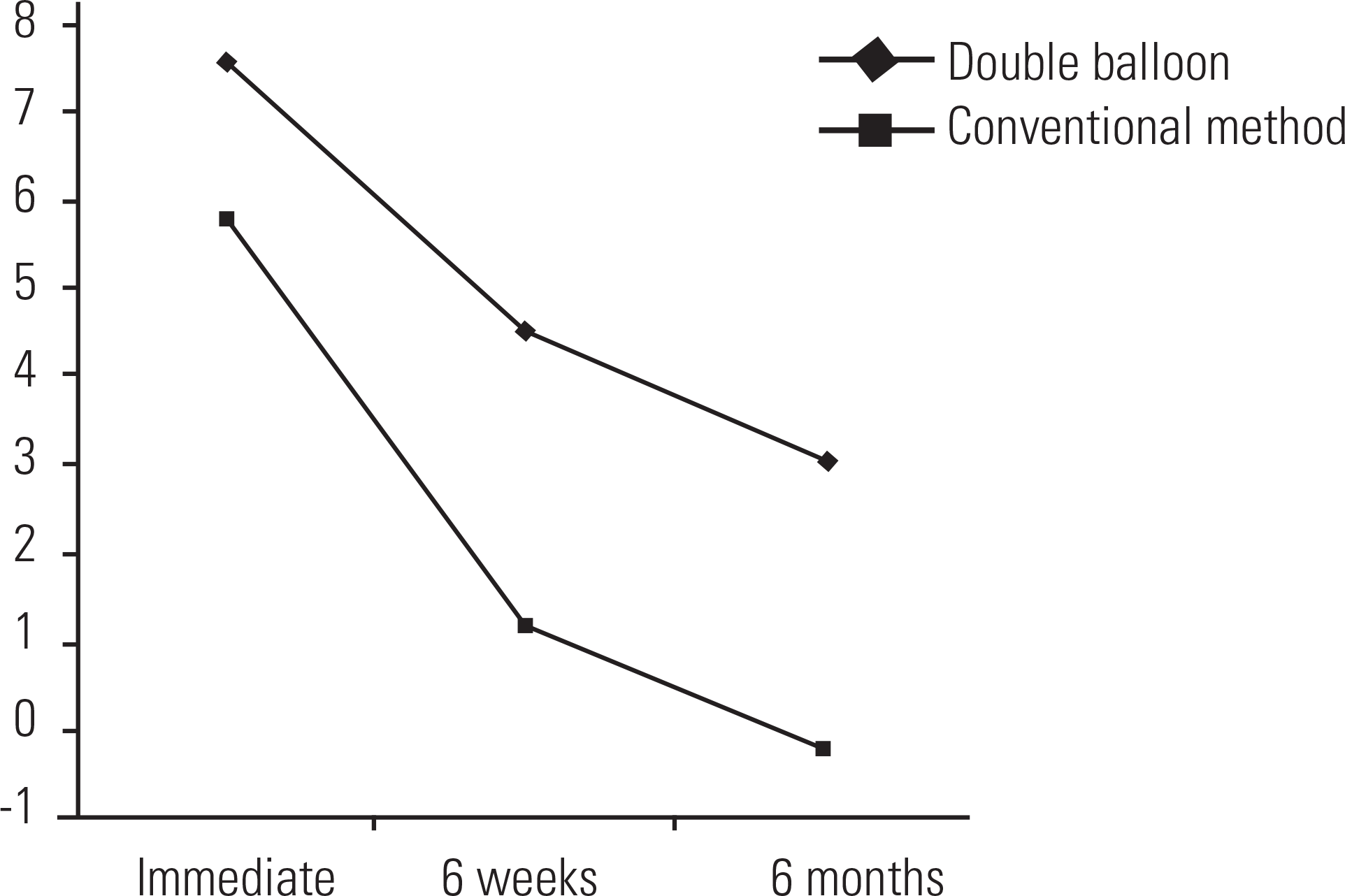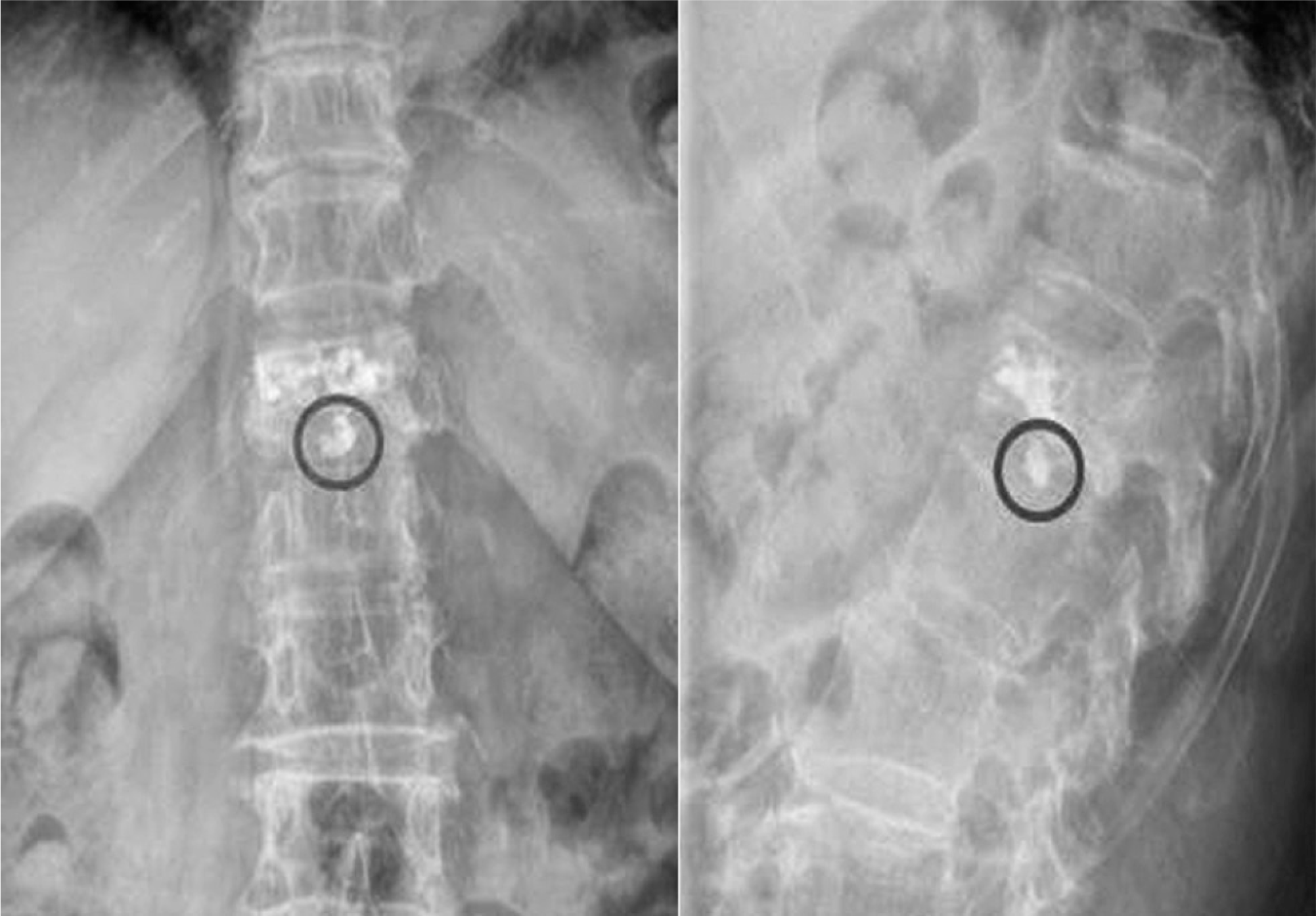Abstract
Objectives
We analyzed the radiological results of the double-balloon inflation technique in terms of its ability to reduce cement leakage, to increase bone cement bonding, and to promote anterior column height recovery.
Summary of Literature Review
Various methods, such as the egg-shell technique, have been proposed to prevent leakage of cement during kyphoplasty in cases of osteoporotic compression fracture.
Materials and Methods
This study analyzed 18 patients diagnosed with osteoporotic compression fracture of the lumbar spine who underwent the double-balloon inflation technique after April 2015, and 30 consecutive patients with the same diagnosis who were treated using the conventional method prior to April 2015. We analyzed the radiological results on immediate postoperative simple X-rays in the anteroposterior and lateral views, 6-week postoperative lateral X-rays, and 6-month postoperative lateral X-rays to detect changes in anterior vertebral height and the cement leakage rate.
Results
The average anterior vertebral height increased by 7.58 mm in the double-balloon inflation group, and by 5.8 mm in the conventional group on the immediate postoperative radiographs (p=0.044). On average, a decrease of 3.08 mm was observed at 6 weeks postoperatively in the double-balloon inflation group, in contrast to a decrease of 4.68 mm in the conventional group (p=0.149). At the 6-month postoperative follow-up, an average decrease of 1.45 mm was found in the double-balloon inflation technique group, while a decrease of 1.40 mm was found in the conventional group (p=0.9110). The cement leakage rate was 22% in the double-balloon inflation group and 27% in the conventional group (p=0.730).
Go to : 
REFERENCES
1. Dohm M, Black CM, Dacre A, et al. A randomized trial comparing balloon kyphoplasty and vertebroplasty for vertebral compression fractures due to osteoporosis. AJNR Am J Neuroradiol. 2014 Dec; 35(12):2227–36. DOI: 10.3174/ajnr.A4127.

2. Lee JK, Jeong HW, Joo IH, et al. Percutaneous balloon kyphoplasty for the treatment of very severe osteoporotic vertebral compression fractures: a case-control study. Spine J. 2018 Jun; 18(6):962–9. DOI: 10.1016/j.spinee.2017.10.006.

3. Lee SK, Lee SH, Yoon SP, et al. Quality of Life Comparison between Vertebroplasty and Kyphoplasty in Patients with Osteoporotic Vertebral Fractures. Asian Spine J. 2014 Dec; 8(6):799–803. DOI: 10.4184/asj.2014.8.6.799.

4. Ha KY, Kim YH, Yoo SR, et al. Bone Cement Dislodgement: One of Complications Following Bone Cement Augmentation Procedures for Osteoporotic Spinal Fracture. J Korean Neurosurg Soc. 2015 May; 57(5):367–70. DOI: 10.3340/jkns.2015.57.5.367.

5. Kita K, Takata Y, Higashino K, et al. Surgical Removal of Circumferentially Leaked Polymethyl Methacrylate in the Epidural Space of the Thoracic Spine after Percutaneous Vertebroplasty. Surg J (N Y). 2017 Feb 10; 3(1):E1–5. DOI: 10.1055/s-0037-1598030.

6. Wu CC, Lin MH, Yang SH, et al. Surgical removal of extravasated epidural and neuroforaminal polymethylmethacrylate after percutaneous vertebroplasty in the thoracic spine. Eur Spine J. 2007 Dec; 16(3 Suppl):326–31. DOI: 10.1007/s00586-006-0237-2.

7. Elnoamany H. Percutaneous Vertebroplasty: A New Serial Injection Technique to Minimize Cement Leak. Asian Spine J. 2015 Dec; 9(6):855–62. DOI: 10.4184/asj.2015.9.6.855.

8. Greene DL, Isaac R, Neuwirth M, et al. The eggshell technique for prevention of cement leakage during kyphoplasty. J Spinal Disord Tech. 2007 May; 20(3):229–32. DOI: 10.1097/01.bsd.0000211276.76024.30.

9. Sabuncuoglu H, Dincer D, Guclu B, et al. Intradural cement leakage: a rare complication of percutaneous vertebroplasty. Acta Neurochir (Wien). 2008 Aug; 150(8):811–5. DOI: 10.1007/s00701-008-1503-3.

10. Lee JH, Lee DO, Lee JH, et al. Comparison of radiological and clinical results of balloon kyphoplasty according to anterior height loss in the osteoporotic vertebral fracture. Spine J. 2014 Oct 1; 14(10):2281–9. DOI: 10.1016/j.spinee.2014.01.028.

11. Kim YY, Rhyu KW. Recompression of vertebral body after balloon kyphoplasty for osteoporotic vertebral compression fracture. Eur Spine J. 2010 Nov; 19(11):1907–12. DOI: 10.1007/s00586-010-1479-6.

12. Li D, Wu Y, Huang Y, et al. Risk factors of recompression of cemented vertebrae after kyphoplasty for osteoporotic vertebral compression fractures. Int Orthop. 2016 Jun; 40(6):1285–90. DOI: 10.1007/s00264-016-3203-6.

13. Kruger A, Oberkircher L, Kratz M, et al. Cement interdigitation and bone-cement interface after augmenting fractured vertebrae: A cadaveric study. Int J Spine Surg. 2012 Dec 1; 6:115–23. DOI: 10.1016/j.ijsp.2012.02.005.
14. Lador R, Dreiangel N, Ben-Galim PJ, et al. A pictorial classification atlas of cement extravasation with vertebral augmentation. Spine J. 2010 Dec; 10(12):1118–27. DOI: 10.1016/j.spinee.2010.09.020.

15. Feng L, Shen JM, Feng C, et al. Comparison of radiofrequency kyphoplasty (RFK) and balloon kyphoplasty (BKP) in the treatment of vertebral compression fractures: A meta-analysis. Medicine (Baltimore). 2017 Jun; 96(25):E7150. DOI: 10.1097/MD.0000000000007150.
16. Li H, Yang DL, Ma L, et al. Risk Factors Associated with Adjacent Vertebral Compression Fracture Following Percutaneous Vertebroplasty After Menopause: A Retrospective Study. Med Sci Monit. 2017 Nov 5; 23:5271–6. DOI: 10.12659/MSM.907364.

17. Zhang H, Xu C, Zhang T, et al. Does Percutaneous Vertebroplasty or Balloon Kyphoplasty for Osteoporotic Vertebral Compression Fractures Increase the Incidence of New Vertebral Fractures? A Meta-Analysis. Pain Physician. 2017 Jan-Feb; 20(1):E13–28.
Go to : 
 | Fig. 1.Double-balloon technique in kyphoplasty. (A, B) Balloon insertion into the dough state of the cement core. (C) Expansion to make an internal cast and to increase cement bone interdigitation. (D) Removal of the balloon, followed by reinsertion of the cement into the core. |




 PDF
PDF ePub
ePub Citation
Citation Print
Print




 XML Download
XML Download